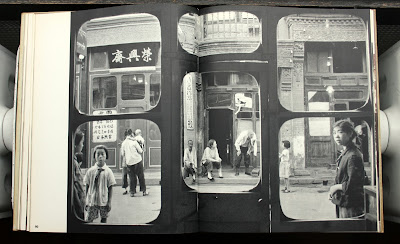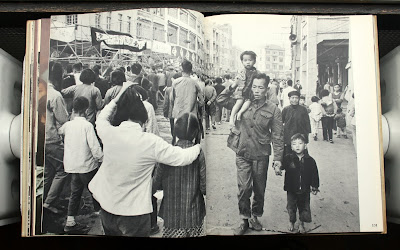The Three Banners of China
Riboud, Marc
Published by The Macmillan Company, New York, 1966
VG/G(-) first Edition HC copy. 216 pp., 50 color photos and over 100 black/white gravures. Across 12 of China's 18 provinces, Riboud viisted communes, schools, small shops, deserted temples, industrial suburbs and large cities. The book is divided into three sections that illlustrate the "three banners" -- the People's Communes, the Great Leap Forward, and the new General Party Line. Size: 10-1/2 x 8-1/2 Inches.
The Chinese Photobook
PARR, MARTIN / WASSINK, LUNDGREN ISBN 10: 1597112283 / ISBN 13: 9781597112284
Publisher/Verlag: Thames & Hudson | From the 1900s to the Present | In the last decade there has been a major reappraisal of the role and status of the photobook within the history of photography. Newly revised histories of photography as recorded via the photobook have added enormously to our understanding of the mediums culture, particularly in places that are often marginalized, such as Latin America and Africa. However, until now, only a handful of Chinese books have made it onto historians short lists. Yet China has a fascinating history of photobook publishing, and The Chinese Photobook will reveal for the first time the richness and diversity of this heritage. This deluxe, lavishly produced volume is based on a collection compiled by Martin Parr and Beijing- and London-based Dutch photographer team WassinkLundgren. And while the collection was inspired initially by Parrs interest in propaganda books and in finding key works of socialist realist photography from the early days of the Communist Party and the Cultural Revolution era, the selection of books includes key volumes published as early as 1900, as well as contemporary volumes by emerging Chinese photographers. | Format: Hardback | Language/Sprache: english | 448 pp.
The day I first met Marc Riboud, we rode an open-air elevator to the top of the nearly completed New York Times building on Eighth Avenue. It was 2007; Mr. Riboud was 84. He had been commissioned by the architect Renzo Piano to document the tower’s construction, and he hired me to assist him. Mr. Riboud darted from one side of the elevator to the other taking pictures, chatting with the operator. The warm air moved his silver hair in all directions as we defied gravity and eventually arrived at the roof of the 52-story building.
Stepping off the elevator and into the world of wary construction workers dancing above the sun-drenched city on silver scaffolding, it didn’t take long for Mr. Riboud to engage them with his wit and humor. The same crew who had eyed us with uncertainty an hour before waved and smiled as we left, and told us to come back soon.
I didn’t know Mr. Riboud well, but that day I quickly learned of his immense warmth and boundless curiosity, the same qualities that allowed him to connect with countless individuals and cultures throughout his career. For more than 60 years, Mr. Riboud, who was born in Lyon, France, in 1923, has collected the humor, grace, anguish and beauty of fleeting moments around the world. The archive he has assembled of nuanced and compassionate images — form and content harmonized — is immense.

The pictures he captured on top of the Times building that day call to mind one of his best-known photographs, which was also his first published image, made in 1953. It depicts a man in splattered overalls, poised between iron beams — theatrical and acrobatic — painting the Eiffel Tower. His nimble feet, inside cloth shoes that allowed him to feel every detail of the structure beneath, are the only measure of safety holding him far above the hazy cityscape of Paris.
It was also in 1953 that he began his long association with Magnum Photos, where he would be mentored by Henri Cartier-Bresson and Robert Capa. He stayed with the agency for nearly 30 years.
He crossed the Middle East and Afghanistan during the 1950s, landing in India, where he lived for a year. There, in Benares (now Varanasi), on the banks of the Ganges River, Mr. Riboud made an extraordinary and lyrical image of two men and a woman shortly after they had bathed. He describes the experience in “Vers L’Orient,” writing, “The simplest gestures had the grace of a celebration, and the long continuous line of arm and shoulder in a man drying his dhoti in the sun unfurled like an unbroken musical phrase, legato, legato.”
He next traveled to China, arriving in 1957, where he made images that are now part of “Witness at a Crossroads: Photographer Marc Riboud in Asia,” an exhibition opening Oct. 16 at the Rubin Museum of Art. The exhibition, curated by Beth Citron, reveals moments and details of everyday life between 1955 and 1958 in Turkey, Iran, Afghanistan, Pakistan, India, Nepal, China and Japan. Also included are treasures such as letters between Mr. Riboud and Mr. Cartier-Bresson, contact sheets, his passport and his first Leica M3, the very one with which he began his travels through Asia.
Mr. Riboud follo wed the indepen dence move ments across Algeria and West Africa in the 1960s and was one of few photographers allowed to travel in North and South Vietnam between 1968 and 1969. Another celebrated image, made in the United States in the same era, shows a young woman named Jan Rose Kasmir bravely holding a single daisy before a row of bayonet-wielding soldiers at a Vietnam War protest outside the Pentagon. The image is a study in contradictions: Ms. Kasmir’s soft floral blouse against the soldiers’ stiff uniforms, bare hands against gloved hands, ruffled hair against helmets, youth against the system, peace against war.

Throughout the 1970s and 1980s, and into the 21st century, Mr. Riboud returned to the Near and Far East, roaming, listening and gathering photographs with eyes led by his heart. It is undeniable that he captured history, yet the soul of his work lies in the less noticeable moments within those occasions.
Six years ago, in the autumn of 2008, Mr. Riboud traveled to New York to photograph scenes of the historic presidential election, and again asked me to assist. As Barack Obama emerged victorious on Nov. 4, ecstatic crowds erupted in Times Square. Mr. Riboud insisted we leave behind the quiet viewing party at Elliott Erwitt’s home and enter the fray of Midtown. After several loops in and out of Times Square — Mr. Riboud’s camera never far from his eye — he asked me to guide him to a local bar where he could continue photographing the revelers. We made our way to Rudy’s Bar and Grill, a quintessential dive bar in Hell’s Kitchen known for cheap beer, free hot dogs and the oversize plastic pig in the entryway. Mr. Riboud photographed the celebration into the night, delighted to be a part of it.
I recently asked Cathe rine Chaine, Mr. Riboud’s wife, what she believed made a particular image from Shanghai in 2002 so special. The photo shows an abandoned plastic bag atop an unadorned cement pillar. The handles have been tied together by the absent owner and left upright, transforming the bag into a white rabbit.
“His gift to see the beauty where we cannot,” she replied.
Mr. Riboud’s exhibit, “Witness at a Crossroads: Photographer Marc Riboud in Asia,” opens on Oct. 16 at the Rubin Museum of Art.
Sarah Stacke is a photographer based in Brooklyn and Durham, N.C. She is working on a publication about Hugh Mangum’s life and work.


















































Geen opmerkingen:
Een reactie posten